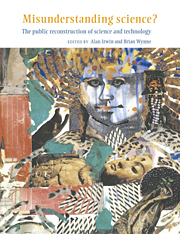Book contents
- Frontmatter
- Contents
- Acknowledgements
- Introduction
- 1 Misunderstood misunderstandings: social identities and public uptake of science
- 2 Science and Hell's kitchen: the local understanding of hazard issues
- 3 Disembodied knowledge? Making sense of medical science
- 4 Now you see it, now you don't: mediating science and managing uncertainty in reproductive medicine
- 5 Ignoring science: discourses of ignorance in the public understanding of science
- 6 Insiders and outsiders: identifying experts on home ground
- 7 Authorising science: public understanding of science in museums
- 8 Nature's advocates: putting science to work in environmental organisations
- 9 Proteins, plants, and currents: rediscovering science in Britain
- Conclusions
- Notes on contributors
- Select bibliography
- Index
Introduction
Published online by Cambridge University Press: 16 October 2009
- Frontmatter
- Contents
- Acknowledgements
- Introduction
- 1 Misunderstood misunderstandings: social identities and public uptake of science
- 2 Science and Hell's kitchen: the local understanding of hazard issues
- 3 Disembodied knowledge? Making sense of medical science
- 4 Now you see it, now you don't: mediating science and managing uncertainty in reproductive medicine
- 5 Ignoring science: discourses of ignorance in the public understanding of science
- 6 Insiders and outsiders: identifying experts on home ground
- 7 Authorising science: public understanding of science in museums
- 8 Nature's advocates: putting science to work in environmental organisations
- 9 Proteins, plants, and currents: rediscovering science in Britain
- Conclusions
- Notes on contributors
- Select bibliography
- Index
Summary
One of the most routine observations about modern life concerns the rapid pace of technical change and the consequences of this for every aspect of society. Of course, this is not just a phenomenon of the 1990s. The social impact of ceaselessly changing science and technology has been a classical theme of writers, social scientists and scientists since the Industrial Revolution. Generally, the tone has been deterministic, suggesting that science and technology have their own objective logic to which society must adapt as best it can.
However, the relationship between scientific expertise and the ‘general public’ is currently a matter of renewed attention and social concern. Although the dominant form of this renewed interest is shaped by anxieties about the ‘social assimilation’ of science and technology (i.e. by a concern that the public are insufficiently receptive to science and technology), we will argue that this conceals a more fundamental issue regarding the public identity and organisation of science within contemporary society.
This edited collection focuses on one important aspect of this wider theme; the contemporary issue of what has become known as the ‘public understanding of science’. As the following chapters demonstrate, this has become something of a fulcrum for debates over the social negotiation of power and social order in relation to science and technology. In this Introduction, we will first set the scene for the detailed analyses which follow and then explain the particular approach to this debate which has been adopted here. As this book demonstrates, concern with ‘public understanding’ takes us into many areas of case-study and socio-technical inquiry – it is thus all the more important to establish from the outset the major interlinkages and connections.
- Type
- Chapter
- Information
- Misunderstanding Science?The Public Reconstruction of Science and Technology, pp. 1 - 18Publisher: Cambridge University PressPrint publication year: 1996
- 31
- Cited by

